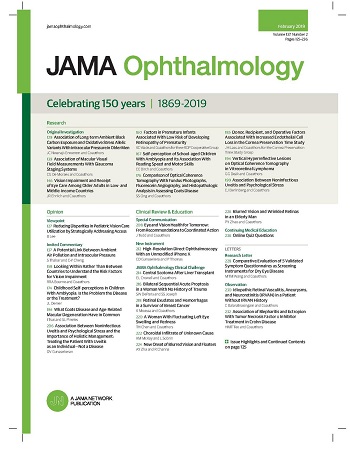Visual Acuity and Complications at Age 7 Years Following Bilateral Secondary Intraocular Lens Implantation at 2 to Younger Than 6 Years for Pediatric Aphakia.
IF 7.8
1区 医学
Q1 OPHTHALMOLOGY
引用次数: 0
Abstract
Importance The optimal timing for secondary intraocular lens (IOL) implantation in children with bilateral aphakia remains uncertain, with important implications for long-term visual outcomes and the risk of complications such as glaucoma. Determining when to implant to achieve the best visual outcomes while minimizing complications is critical for improving clinical decision-making in pediatric cataract management. Objective To report the visual acuity (VA) and complications in children with bilateral aphakia after lensectomy for pediatric cataracts, undergoing secondary IOL implantation at different ages. Design, Setting, and Participants This single-center prospective observational cohort study, conducted from 2014 to 2023, is a 7-year follow-up study. A total of 251 children met the inclusion criteria. After exclusion, 158 children were enrolled in this study. These 158 children (316 eyes) underwent lensectomy before the age of 2 years, followed by secondary IOL implantation between the ages of 2 and younger than 6 years in bilateral pediatric cataracts. Exposure Study participants were categorized into 4 groups based on the timing of secondary IOL implantation (2 to <3 years, 3 to <4 years, 4 to <5 years, and 5 to <6 years). Main Outcome and Measure Best-corrected VA (BCVA) outcomes at age 7 years after secondary IOL implantation in children with bilateral pediatric cataracts. Results Among the 158 children included in the study, 103 (65.2%) were male. At age 7 years, the mean (SD) BCVA for children who underwent secondary IOL implantation was 0.49 (0.35) logMAR (Snellen equivalent, 20/62) at 2 to younger than 3 years, 0.59 (0.36) logMAR (Snellen equivalent, 20/78) at 3 to younger than 4 years, 0.60 (0.30) logMAR (Snellen equivalent, 20/80) at 4 to younger than 5 years, and 0.65 (0.34) logMAR (Snellen equivalent, 20/89) at 5 to younger than 6 years (P = .20). Glaucoma-related adverse events occurred in 47 eyes in total: 6 eyes (8.8%), 7 eyes (9.0%), 10 eyes (15.6%), and 24 eyes (22.6%) across the groups, respectively, with a statistical difference among the groups (P = .03). Conclusions and Relevance These findings suggest that secondary IOL implantation performed between the ages of 2 and younger than 6 years following bilateral pediatric cataract lensectomy can achieve comparable visual outcomes; however, the risk of glaucoma increases with older implantation age.儿童无晶状体2岁至6岁以下双侧继发性人工晶状体植入术后7岁视力及并发症。
双侧无晶状体儿童二期人工晶状体植入术的最佳时机仍不确定,这对长期视力结果和青光眼等并发症的风险具有重要意义。确定何时植入以获得最佳视力结果,同时最大限度地减少并发症是提高儿童白内障治疗临床决策的关键。目的分析不同年龄儿童白内障晶状体切除术后双侧无晶状体植入术后的视力及并发症。设计、环境和参与者这项单中心前瞻性观察队列研究于2014年至2023年进行,是一项为期7年的随访研究。共有251名儿童符合纳入标准。排除后,158名儿童入组本研究。158名儿童(316眼)在2岁前接受晶状体切除术,随后在2岁至6岁以下的双侧儿童白内障中进行二次人工晶状体植入术。研究参与者根据二次人工晶体植入术的时间分为4组(2至<3年,3至<4年,4至<5年和5至<6年)。双侧儿童白内障继发性人工晶状体植入术后7岁时最佳矫正VA (BCVA)结果。结果158例患儿中,男性103例(65.2%)。在7岁时,接受二次人工晶体植入术的儿童的平均(SD) BCVA在2至3岁以下为0.49 (0.35)logMAR (Snellen当量,20/62),在3至4岁以下为0.59 (0.36)logMAR (Snellen当量,20/78),在4至5岁以下为0.60 (0.30)logMAR (Snellen当量,20/80),在5至6岁以下为0.65 (0.34)logMAR (Snellen当量,20/89)(P = 0.20)。青光眼相关不良事件共发生47只眼,组间分别为6只眼(8.8%)、7只眼(9.0%)、10只眼(15.6%)、24只眼(22.6%),组间差异有统计学意义(P = 0.03)。结论和相关性这些研究结果表明,2岁至6岁以下儿童双侧白内障晶状体切除术后二期人工晶状体植入术可以获得相当的视力结果;然而,青光眼的风险随着植入年龄的增加而增加。
本文章由计算机程序翻译,如有差异,请以英文原文为准。
求助全文
约1分钟内获得全文
求助全文
来源期刊

JAMA ophthalmology
OPHTHALMOLOGY-
CiteScore
13.20
自引率
3.70%
发文量
340
期刊介绍:
JAMA Ophthalmology, with a rich history of continuous publication since 1869, stands as a distinguished international, peer-reviewed journal dedicated to ophthalmology and visual science. In 2019, the journal proudly commemorated 150 years of uninterrupted service to the field. As a member of the esteemed JAMA Network, a consortium renowned for its peer-reviewed general medical and specialty publications, JAMA Ophthalmology upholds the highest standards of excellence in disseminating cutting-edge research and insights. Join us in celebrating our legacy and advancing the frontiers of ophthalmology and visual science.
 求助内容:
求助内容: 应助结果提醒方式:
应助结果提醒方式:


